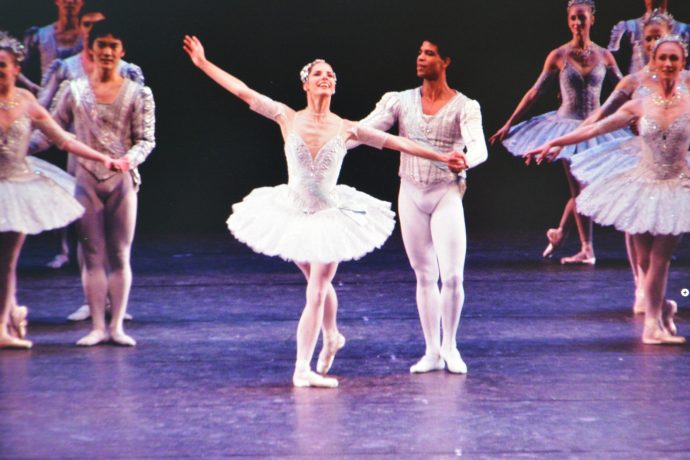We went in to Lincoln Center to see the American Ballet Theater during its summer season to watch “ZigZag,” the new ballet by Jessica Lang with music by Tony Bennett. Little did I know that I would be confronted with a lesson about the world’s shifting zeitgeist.
The ABT program included Balanchine’s “Theme and Variations” created in 1947 and with music by Tchaikovsky, followed by Alonzo King’s “Single Eye” made in 2022 and with music by Jason Moran and then “ZigZag,” which had its world premiere nine months ago.
I should have realized I was about to witness a clash of paradigms. Balanchine created “Theme and Variations” in 1947, before the onslaught of post-modernism. Fast forward 70 years to 2022 where we live in a world of confusion, loneliness and narcissism. The ABT program exemplified that change with remarkable clarity.
Let us begin by describing “Theme and Variations” by George Balanchine, the genius of geometry. Balanchine was a Russian immigrant, who trained in classical music and dance at the Imperial Theater Ballet School in St. Petersburg Russia, settled in New York City and founded the New York City Ballet. His “Theme and Variations” evokes the great period of classical ballet and like his masterpieces, “Concerto Barocco” and “Serenade,” it shows us dancers who embody cooperation.
Balanchine subordinated star power to teamwork and devotion to the music. Throughout the piece you see his dancers holding hands, on pointe and moving as an intertwining chain of jewels. The impact is moving. Add to this the music, “Suite #3 for Orchestra” by Peter Ilyich Tchaikovsky, and dancers like Herman Cornejo, and you have a thing of beauty from the soul of George Balanchine.
Balanchine will eventually be known as one of the greatest artists of the last 1,000 years, comparable to a Leonardo Da Vinci, a Rembrandt or a Bach or Beethoven. But, alas, greatness is a tough act to follow and the next group is forced in another direction. So, in art after Rembrandt you get Picasso. Yes, Picasso is a wonderfully creative artist, but he’s not Rembrandt.
And in the field of choreography, after George Balanchine, you get William Forsythe, Pina Bausch and Twyla Tharp. Yes, they are all wonderfully creative artists, but they are not George Balanchine. Great artists create a paradigm, which then becomes rigid and in turn the field breaks away into a new realm.
Thanks to television, computers and social media we now live in a world of narcissism, confusion and loneliness. We are more alienated from each other than ever before. And the next two pieces on the program were perfect exemplars of this state of mind. They both demonstrated the paradigm shift in dance and also serve to reflect who we are in 2022.
“Single Eye” by Alonzo King was a perfect expression of the world we live in today. In the kingdom of the blind, the man with one eye is king. And this is what I saw in this piece. You had either dancers moving alone and unaware of each other or you had duets that were in antagonistic relation with each other. Welcome to today’s world filled with isolation and aggression. And just as Tharp and Bausch and Forsythe are wildly creative, so is Alonzo King.
Which takes us to the last piece, “ZigZag,” by Jessica Lang. How can you not love a piece choreographed to the music of Tony Bennett? This is a new arrival to the dance world, but by using the music of Tony Bennet, it was an attempt to embrace the 1950s when he was young and a king. The costumes by Wes Gordon for Carolina Herrera were worth the price of admission with luscious dresses of bright yellow, bright red and bright blue.
It’s difficult for a choreographer and dancer to compete with words from the pens of Irving Berlin and Cole Porter and sung by Bennett. Who’s on top in that scenario, the choreographer, the dancer, the lyricist or the singer? The mind gets confused and you wind up giving into Tony Bennett and listening to his sweet voice while ignoring the dancers.
The entire dance was saved, however, by the last movement to the tune “How do you keep the music playing” by Alan and Marilyn Bergman. This song was a poignant lament about how things like love and music fade away. It starts with the line “How do you keep the music playing? How do you make it last?”
This song was danced by the entire cast and was a lovely plea that we all ask ourselves as we age. How do we keep the spark alive and how to we keep having fun? Who could have guessed we could learn so much from three dance pieces at American Ballet Theater?
We who live near Manhattan are lucky to be witness to many miracles. The miracle of Lincoln Center, George Balanchine, Peter Tchaikovsky, the orchestra in the pit, all those world class dancers with the slim and perfect bodies and straight backs who have been trained to move their hands and arms in the air just so.
Thank you ABT for a glorious summer season in NYC. After the show we strolled through Central Park and had dinner at Tavern on the Green. It’s good to be a New Yorker.

